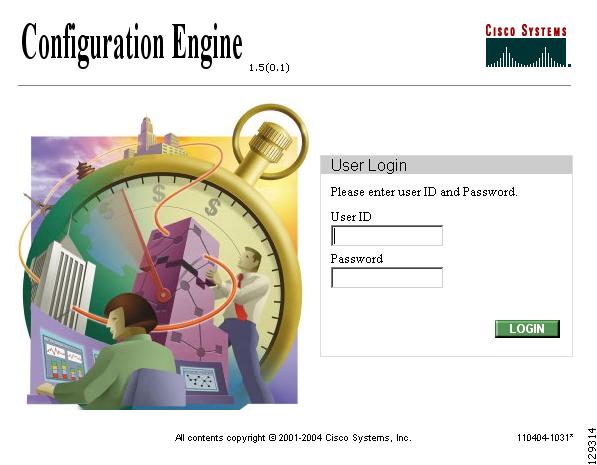- Index
- Preface
- Product Overview
- Graphical User Interface
- Device and Subdevice Manager
- User Account Manager
- Configuration and Image Update Jobs Manager
- Groups
- Namespace Manager
- Query Manager
- Data Manager
- Directory Manager
- Parameter Manager
- Templates
- Security Manager
- Log Manager
- Service Manager
- Bulk Data Manager
- Email Manager
- Image Service
- Agent Enabled to Non-agent Enabled Up/Downgrades
- Backup and Restore
- Miscellaneous Administrator Tasks
- Pix Firewall Device Support
- IMGW Device Module Development Toolkit
- Troubleshooting
- Software Licenses and Acknowledgements
Graphical User Interface
This chapter provides general information about the graphical user interface (GUI).
Logging In and Out
You can connect to the system by means of:
•![]() SSH
SSH
•![]() System console
System console
Logging In
Step 1 ![]() Launch your web browser.
Launch your web browser.
This user interface is best viewed using Microsoft Internet Explorer, version 5.5 or later.
Step 2 ![]() Go to the Cisco Configuration Engine URL.
Go to the Cisco Configuration Engine URL.
For example: http://<ip_address>

Note ![]() If encryption is set during Setup, use https://<ip_address>.
If encryption is set during Setup, use https://<ip_address>.
The login window appears (see Figure 2-1).
Figure 2-1 Logging Into the Configuration Engine

Step 3 ![]() Enter your User ID.
Enter your User ID.
This is the value for the ConfigService AdminID parameter that you entered during Setup.
Step 4 ![]() Enter your password.
Enter your password.
Step 5 ![]() Click LOGIN.
Click LOGIN.
For an Administrator, the full-function Cisco Configuration Engine Home page appears (see Figure 2-2).
For an Operator, a limited-function Cisco Configuration Engine Home page appears without access to user-related tasks.
Figure 2-2 Administrator-level Home Page

Logging Out
To log out of the system, click the Logout button.
Levels of Access
In Internal Directory mode, there are two categories of users who have access to device information:
•![]() Administrator
Administrator
•![]() Operator
Operator
An Administrator has full access to system administration tasks. An Operator has access to only limited set of tasks (see "Operator-Level Operations" section).
Operator-Level Operations
After logging into the Cisco Configuration Engine, an Operator has access to the following functions:
•![]() Device
Device
–![]() Add
Add
–![]() Edit
Edit
–![]() Subdevices
Subdevices
–![]() Update Device
Update Device
–![]() Query Device Inventory
Query Device Inventory
•![]() Tools
Tools
–![]() Change Password
Change Password
–![]() View Event Log
View Event Log
–![]() View Image Server Log
View Image Server Log
•![]() Jobs
Jobs
–![]() Query Job
Query Job
–![]() Cancel/Stop Job
Cancel/Stop Job
–![]() Restart Job
Restart Job
•![]() Image Service
Image Service
–![]() View Image
View Image
Administrator-Level Operations
An Administrator can access all of the functions provided by the Cisco Configuration Engine user interface in both Internal Directory mode and External Directory mode.
Feature Operations
The Cisco Configuration Engine 1.5 GUI (see Figure 2-2) provides the following feature operations:
•![]() Devices - Click this tab to conduct operations on Devices and Subdevices (see "Device and Subdevice Manager").
Devices - Click this tab to conduct operations on Devices and Subdevices (see "Device and Subdevice Manager").
•![]() Users - Click this tab to operate on user accounts (see "User Account Manager").
Users - Click this tab to operate on user accounts (see "User Account Manager").
•![]() Jobs - Click this tab to access background update tasks that have been assigned a Job IDs (see "Configuration and Image Update Jobs Manager").
Jobs - Click this tab to access background update tasks that have been assigned a Job IDs (see "Configuration and Image Update Jobs Manager").
•![]() Tools - Click this tab to access the following features:
Tools - Click this tab to access the following features:
–![]() Group Manager (see "Groups").
Group Manager (see "Groups").
–![]() Namespace Manager (see "Namespace Manager").
Namespace Manager (see "Namespace Manager").
–![]() Query Manager (see"Query Manager").
Query Manager (see"Query Manager").
–![]() Data Manager (see "Data Manager").
Data Manager (see "Data Manager").
–![]() Directory Manager (see "Directory Manager").
Directory Manager (see "Directory Manager").
–![]() Template Manager (see "Templates").
Template Manager (see "Templates").
–![]() Security Manager (see "Security Manager").
Security Manager (see "Security Manager").
–![]() Log Manager (see "Log Manager").
Log Manager (see "Log Manager").
–![]() Service Manager (see "Service Manager").
Service Manager (see "Service Manager").
–![]() Bulk Data Manager (see "Bulk Data Manager").
Bulk Data Manager (see "Bulk Data Manager").
–![]() Email Manager (see "Email Manager").
Email Manager (see "Email Manager").
•![]() Image Service - Click this tab to work with Images and Search Parameters (see "Image Service").
Image Service - Click this tab to work with Images and Search Parameters (see "Image Service").
 Feedback
Feedback